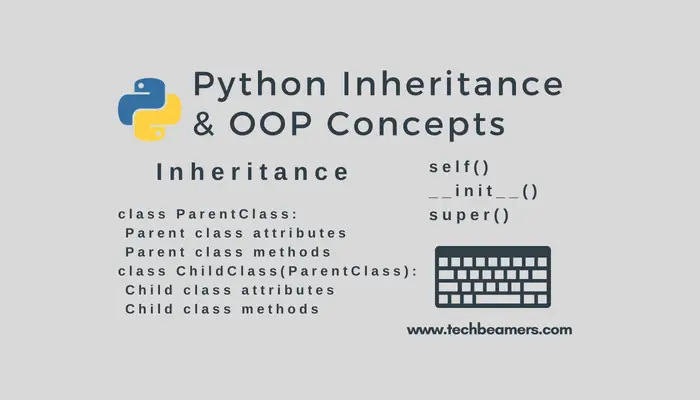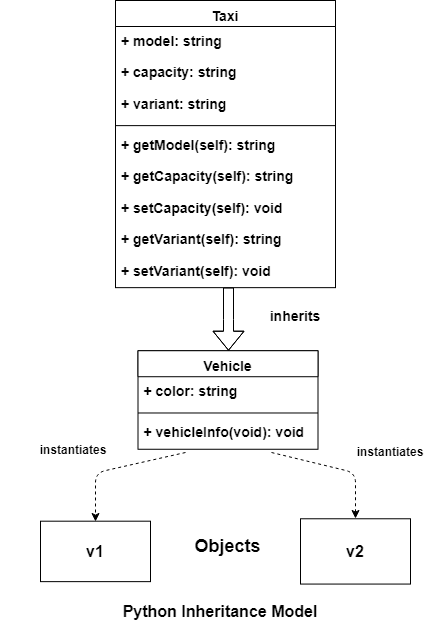In this tutorial, you will learn about Python class Inheritance which is one of the core concepts of object-oriented programming. We have added sufficient examples to give you hands-on experience.
By the end of this tutorial, you will be able to write Python programs that use inheritance. You will learn about the super() function, which allows you to access methods and attributes from the parent class. Additionally, you will also learn how to extend classes and override their methods and attributes.

Python Class Inheritance – Introduction
Inheritance is a generic concept available in all object-oriented programming languages like C++, Java, and Python.
It represents the relationship of a class with another class. The mechanism behind inheritance makes a class derive all the features from its parent class. While the child class can have its own.
We recommend reading the Python class and methods tutorial first if you’ve not already gone through it.
In the next tutorial, we are going to cover the concept of Multiple Inheritance (with examples) in Python.
What does inheritance mean for a Class?
Inheritance is the core feature of object-oriented programming which extends the functionality of an existing class by adding new features. You may compare it with real-life situations when a child inherits the property of his parents in addition to adding his own. He may even derive the surname (the second name) from his parents.
What is the purpose of inheritance?
By using the inheritance feature, we can have a new blueprint with old attributes but without making any changes to the original one. We refer to the new class as the derived or child class whereas the old one becomes the base or parent class.
How to implement inheritance in Python?
You can introduce inheritance by using the following syntax.
class ParentClass: Parent class attributes Parent class methods class ChildClass(ParentClass): Child class attributes Child class methods
Inheritance automatically brings reusability to your code as the derived class has got everything from the base class.
Also Learn: Data Classes in Python
Python inheritance example
To understand the application of inheritance, let’s consider the following example.
Create a base class Taxi and a subclass Vehicle
We have a base class Taxi, and it has a subclass (child) Vehicle.
class Taxi:
def __init__(self, model, capacity, variant):
self.__model = model # __model is private to Taxi class
self.__capacity = capacity
self.__variant = variant
def getModel(self): # getmodel() is accessible outside the class
return self.__model
def getCapacity(self): # getCapacity() function is accessible to class Vehicle
return self.__capacity
def setCapacity(self, capacity): # setCapacity() is accessible outside the class
self.__capacity = capacity
def getVariant(self): # getVariant() function is accessible to class Vehicle
return self.__variant
def setVariant(self, variant): # setVariant() is accessible outside the class
self.__variant = variant
class Vehicle(Taxi):
def __init__(self, model, capacity, variant, color):
# call parent constructor to set model and color
super().__init__(model, capacity, variant)
self.__color = color
def vehicleInfo(self):
return self.getModel() + " " + self.getVariant() + " in " + self.__color + " with " + self.getCapacity() + " seats"
# In method getInfo we can call getmodel(), getCapacity() as they are
# accessible in the child class through inheritance
v1 = Vehicle("i20 Active", "4", "SX", "Bronze")
print(v1.vehicleInfo())
print(v1.getModel()) # Vehicle has no method getModel() but it is accessible via Vehicle class
v2 = Vehicle("Fortuner", "7", "MT2755", "White")
print(v2.vehicleInfo())
print(v2.getModel()) # Vehicle has no method getModel() but it is accessible via Vehicle class
Please note that we have not specified the getName() method in the Vehicle class, but we can access it. It is because the Vehicle class inherits it from the Taxi class.
The output of the above example is as follows.
# output i20 Active SX in Bronze with 4 seats i20 Active Fortuner MT2755 in White with 7 seats Fortuner
Practice Python: Data Class Exercises in Python
Python inheritance’s UML diagram
To bring more clarity, you can refer to the Python inheritance’s UML diagram of the example mentioned above.

The super() method
What does the super() do in Python?
The super() method allows us to access the inherited methods that cascade to a class object.
In the earlier example, we used the super() method in the constructor of the child class <Vehicle>. It is invoking the function of the base class <Taxi>.
How does the super() method work?
Just assume, that you have to invoke a method in the base class, i.e., vehicleInfo() defined in the child class, then you can use the following code.
super().vehicleInfo()
Likewise, you can invoke the base class constructor from the sub (child) class __init__ using the below code.
super().__init__()
☛ Read More: Python Tutorials
Summary – Python Inheritance and OOP
In this tutorial, we covered “Python Inheritance” which is essential in object-oriented programming. Hence, it is necessary that you are aware of how the inheritance works in Python.
Now, if you’ve learned something from this class, then care to share it with your colleagues. Also, connect to our social media accounts to receive in time future updates.
Best,
TechBeamers








